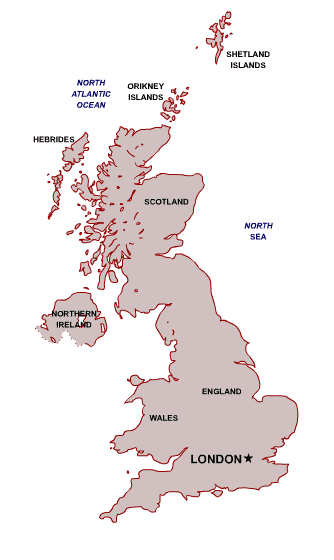|
|
|
THE UNITED
KINGDOM OF GREAT BRITIAN
Maryjane
Brown - Social 20 G.A.T.E.
- - - - - - - - - -
Section
I: Geography
|

Obligatory
Map of the U.K.
|
|
Location:
|
Northern
European island off the West coast
|
|
Physical
environment:
|
-
Low mountainous and hilled regions
-
A 12,429 km coast line
|
|
Climate:
|
-
-5°c - 30°c
- Moderate temperatures
- North Atlantic
current causing frequent overcast |
|
How
does geography hurt or benefit this country?
The
United Kingdom's location relative to the North Pole
and the equator is just north of being centrally set.
Therefore, it's not too warm or too cold to hinder
productivity. In fact, because of the temperature
range and large textile and fashion industry present
within the country, seasonal fashions are at large
thus giving labels the chance to cash in on the predictable
climate change.
The United
Kingdom is at an advantage for being surrounded by
a 12,429 km coast line. This allows another immediate
possibility for transportation of goods from four
continents. Needless to say, it opens up a handful
of other industries such as fishing or boat making
which are otherwise useless industries to the area
because only 1.34% of the total land area is made
up of bodies of water. The other 98.66% is well used
to support the mining industries within the region.
However,
seeing as the country is divided into smaller islands
and regions, there is a potential for the smaller
remote areas to feel subject to inferiority from the
'mainland' and transport between these ocean passages
could be seen as inconveniencing as shipping costs
are more expensive by air or sea as opposed to the
land travel possibilities present within the mainland
United Kingdom.
|
Top
-
- - - - - - - - -
Section
II: History
|
How
has the past affected the current situation?
The
transition of uniting the former countries which today
make up the United Kingdom was a gradual one because
even when having been officially recognized as one
nation, there still remained hostility and long lived
cultural barriers between the regions. However, because
of this union, there had to be a new set of rules
set in play in order to keep members of all sides
satisfied. From there spawned many principles such
as property, capitalism, and parliamentary democracy
as well as many other technological advancements to
facilitate such ideologies which are present not only
in the U.K. but around the world today.
As for
the Monarchal head of state, they are mainly there
to enforce such British traditions and customs rather
than to completely govern the nation.
|
Top
-
- - - - - - - - -
Section
III: Cultural
Diversity
|
Ethnic
groups:
|
 |
| |
Caucasian: |
92.1% |
| |
Black: |
2% |
| |
Indian: |
1.8% |
| |
Pakistani: |
1.3% |
| |
Mixed: |
1.2% |
| |
Other: |
1.6% |
|
|
Religions:
|
 |
| |
Christian |
71.6% |
| |
Muslim: |
2.7%
|
| |
Hindu: |
1% |
| |
Other: |
1.6% |
| |
None: |
23.1% |
|
|
Languages:
|
 |
| |
English: |
74% |
| |
Welsh: |
26% |
|
|
What
are the advantages and disadvantages to these differences?
There
exists little cultural diversity in the United Kingdom.
This means that everything is pretty well aimed at
one target audience with little regard for ethnic
and cultural minorities. However, because of customary
teachings (courteous British manners, if you will),
hate-crime is generally muffled which is not to say
that the United Kingdom is rid of such but is rather
subdued. Differences aren't instantly embraced but
the minorities within the area are steadily growing
which could potentially lead to a wide-scale cultural
division in the near future.
|
Top
-
- - - - - - - - -
Section
IV: Population
|
Doubling
time:
|
3.57 years
|
|
Population
growth:
|
0.28%
|
|
Density:
|
243/km2
|
|
Urban
vs. rural:
|
 |
| |
Urban: |
89% |
| |
Rural: |
11% |
|
|
Dependency
load:
|
 |
| |
Below
14: |
17.5% |
| |
| |
15-64: |
66.8% |
| |
Above
65: |
15.8% |
| |
|
|
Do
you foresee any future problems as a result of growth
or lack of growth?
I
can't foresee any problems arising from population
growth as the rate of increase seems well on par with
other first world countries keeping in mind that the
U.K. it's self is a pretty tiny nation so a slow but
steady population increase is more than ideal.
Even so,
urban sprawl still has plenty of room to eventually
expand into.
|
Top
-
- - - - - - - - -
Section
V: Economics
|
Resources:
|
Coal, petroleum,
natural gas, iron ore, lead, zinc, gold, tin, limestone,
salt, clay, chalk, gypsum, potash, silica sand and
slate
|
|
Industries:
|
Machine
tools, electric power equipment, automation equipment,
railroad equipment, ship building,
aircraft, motor vehicles and parts,
electronics and communication equipment, metals, chemicals,
coal, petroleum, paper and paper products, food processing,
textiles, clothing and other consumer products
|
|
Per-capita
GNP:
|
$21, 250
|
| Debt: |
51%
of GDP ($849, 660, 000) |
|
Can
this country support its people?
I
believe that the U.K. can support its people and their
desired quality of lives as they have a wide array
of exportation opportunities and renewable resources
to flourish off of. Of course the U.K. has a fair
share of annual debt but it's nothing that won't eventually
be repaid from said sources of income.
And if
G.N.P. per capita holds any significance, the most
citizens should be able to easily support a complete
lifestyle.
|
Top
-
- - - - - - - - -
Section
VI: Politics
|
Leadership:
|
H.M. Queen
Elizabeth II (Queen) and Tony Blair (Prime Minister)
|
|
Type
of government:
|
Constitutional
Monarchy
|
| Military
involvement: |
$42, 836,
500, 000/year |
|
Does
the government help or hinder development? Do people
have say in decision-making?
There
being two branches of government in the United Kingdom,
it is highly unlikely that something of controversy
requiring change would be over looked by both the
government as well as the monarchal system therefore
allowing a "second chance" per say for a
subject of public interest to be acknowledge and then
after accepted. As well, there aren't any dramatic
changes made to the governmental system. With this
consistency comes a certain familiarity with the public
to which the government can base their decisions on,
therefore favoring all or most parties.
|
Top
-
- - - - - - - - -
Section
VII: Health &
Education
|
Infant
mortality:
|
5.08 deaths
to 1000 live births
|
|
Life
expectancy:
|
79 years
|
|
Number
of physicians:
|
2.1 physicians/1000
people
|
|
Calorie
consumption:
|
 |
| |
Men:
|
2550
cal/day |
| |
| |
Women: |
1940
cal/day
|
| |
|
|
Literacy
rate:
|
99%
|
|
School
enrolment:
|
98.92 students/year
|
| Number
of teachers: |
0.5 teachers/1000
people
|
|
What
do the statistics tell you about the state of health
and education in this nation?
Throughout
history, the United Kingdom has been notorious for
their elite post-secondary education facilities, scholars
and advancements in virtually every field of study.
Today, these universities are still in use and are
still highly regarded by not only the British people
but by aspiring students worldwide.
Much like
Canada, the majority of schools are publicly funded
however there are still over 2,500 schools under private
ownership, thus giving parents and students control
over where to seek education. Another alternative
available in both sectors are schools which cover
the necessary curriculum requirements while orientating
all subjects around one common study such as Latin
grammar, science or the fine arts.
In each
state owned school, there also exists a volunteer
force of parents, staff members and local community
governors to form a school council which is responsible
for upholding the standards of the school and essentially
creating and enforcing any given rules while still
abiding to official education standards. This way
no two schools operate identically and through this
internal governing force, the school can determine
what is best to meet the needs of the individual schools.
Because
of the sheer number of schools and Britain's reputation
to uphold with education, it's safe to assume that
overall, their system has been refined to meet the
needs of students in most cases.
The same
goes for health in the UK. Despite high caloric consumption
levels and documented lack of exercise, the average
British life span is still fairly high from a global
point of view (the highest being Andorra at 83- a
mere fourteen year difference). The same goes for
the rate of stillbirths which isn't leading to any
significant population decrease.
Health
care dollars are almost entirely derived form tax
payers. This goes without saying that there is potential
for long waiting periods, obsolete equipment and such
but there seems to be a relatively high number of
qualified physicians so even if a major disease epidemic
were to break out (in which case, international attention
would be more than likely involved), the U.K.'s health
care system could continue to function and the citizens
would continue to live relatively healthy and freely
make choices which effect their physical and mental
wellbeing.
|
Top
-
- - - - - - - - -
Section
VIII: Quality
of Life Assesment
|
I would without doubt consider the U.K. to be a first world country. This is because not only do its citizens generally possess the required funds to execute a life style (as reflected by the G.N.P. per-capita) but also because Britain also play roles in bettering other countries quality of life.
Also, statistically speaking, the U.K. also ranks as high (if not higher) than most other confirmed first world countries on censuses and statistics which contribute to a good quality of life (for example the literacy rate, clean air and consumer exports).
|
Top
-
- - - - - - - - -
Section
IX: References
2005
Britannica Almanac
Aneki
-
Retrieved September 26th, from the Internet
CIA
World Fact Book
- Retrieved September 20th,
from the Internet
Globalis
- Retrieved September 26th,
from the Internet
History UK
- Retrieved
September 24th, from the Internet
Nation Master
- Retrieved September 19th, from the
Internet
United
Kingdom @ Wikipedia -
Retrieved
September 18th, from the Internet
Weight
Loss Resources UK -
Retrieved
September 26th, from the Internet
Victorian
Web - Retrieved
September 24th, from the Internet
Top
- - - - - - - - - -
|
|
|






